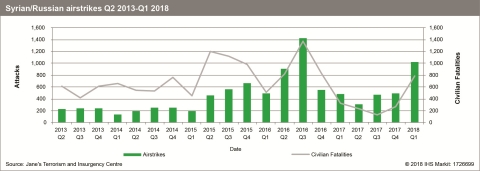Use of Airstrikes in Syrian Conflict Rose by 150 Percent after Russian Intervention, Jane’s by IHS Markit Says
The use of airstrikes by Syrian and Russian forces in the ongoing conflict in Syria has increased 149.8 percent since Russia’s intervention in September 2015, helping the Syrian government to triple the territories under its control, according to a new report from Jane's Terrorism and Insurgency Centre (JTIC) by global business information provider IHS Markit (Nasdaq: INFO).
This press release features multimedia. View the full release here: https://www.businesswire.com/news/home/20180515005798/en/

Syrian/Russian airstrikes Q2 2013 - Q1 2018 (Photo: Business Wire)
“The changing landscape of the conflict in Syria as a consequence of the Russian intervention has provided the Syrian government with the space and time to concentrate forces at key strategic areas and use overwhelming force to recapture opposition-held territory,” said Matthew Henman, head of JTIC at IHS Markit. “JTIC’s recorded data underlines the key role airstrikes have played in this strategy, with opposition forces largely unable to defend against, let alone replicate, the threat posed by airpower.”
Key findings in the report:
- The end of March 2018 marked two and a half years since the launch of Russia’s military intervention in Syria, during which time government territorial control has almost tripled.
- According to data recorded by JTIC, the use of airstrikes has increased dramatically since the Russian intervention, with 6,833 separate instances of Syrian/Russian airstrikes in this period: a 149.8 percent increase from the 2,735 recorded in the preceding two and a half years (April 2013 to September 2015).
- At the same time, however, the number of resultant civilian fatalities from these airstrikes decreased slightly by 9.3 percent from 6,899 in the pre-intervention period to 6,254 in the post-intervention period.
- Syrian/Russian airstrikes have targeted the Islamic State on 960 occasions following Russia’s intervention, accounting for just 14 percent of all such airstrikes in this period.
- According to Conflict Monitor by IHS Markit, the state controlled just 15.9 percent (29,450 square kilometres) of territory in Syria in mid-September 2015. At the end of March 2018, this had almost tripled to 47.4 percent (87,995 sq km) of the country.
More airstrikes but fewer resultant fatalities
“From early 2013 onwards, a major component of state counter-terrorism efforts was the use of airstrikes, which were used against opposition militant targets and in an indiscriminate manner against opposition-controlled territory,” Henman said. “Both tactics frequently resulted in civilian casualties: likely a deliberate, punitive way of punishing civilians deemed supportive of the opposition.”
In the pre-intervention period, Syrian airstrikes comprised more than half (50.6 percent) of all counter-terrorism operations in the period and resulted in 72.1 percent of all civilian fatalities from counter-terrorism operations.
While the number of strikes in the post-intervention period represented a large real-term increase, proportionally Syrian/Russian airstrikes in this period dropped to accounting for 39.5 percent of all counter-terrorism operations, while resulting in an increased 75.0 percent of all civilian fatalities from counter-terrorism operations.
However, in total terms, the resultant number of civilian fatalities from airstrikes decreased slightly by 9.3 percent from 6,899 in the pre-intervention period to 6,254 in the post-intervention period.
Most Syrian/Russian airstrikes in the post-intervention period have not targeted the Islamic State
Russia has claimed that its intervention was launched to target the Islamic State and other hardline militant Islamist groups.
“In the post-intervention period, Syrian/Russian airstrikes have targeted the Islamic State on 960 occasions, accounting for just 14 percent of all such airstrikes in the timeframe,” Henman said. “While a comparatively small proportion, the figures represented both a real-term increase from just 201 airstrikes against the Islamic State in the pre-intervention period, and an increase from 7.3 percent of all airstrikes in the period.”
The vast majority of Syrian/Russian airstrikes in the post-intervention period have targeted opposition groups other than the Islamic State - further underlined when examining the geographical breakdown of airstrikes in this period.
Almost two-thirds (66.2 percent) of all airstrikes in the post-intervention period were conducted in the governorates of Aleppo, Idlib and Damascus and Rif Dimashq, and particularly concentrated in areas where the Islamic State has little to no operational presence. There is a substantial degree of continuity from the pre-intervention period, where those three governorates were again the location of the most airstrikes and collectively accounted for 64.1 percent of all strikes in that timeframe.
Tactical airstrikes have facilitated recovery of territories by Syrian state
Russian intervention has been instrumental in not only ensuring the continued survival of the Assad government but also reversing the momentum of the conflict decisively in favour of government forces against a broad range of opposition forces in the country.
According to Conflict Monitor by IHS Markit, the state controlled just 15.9 percent (29,450 square kilometres) of territory in Syria in mid-September 2015. By contrast, at the end of March 2018, this had almost tripled to 47.4 percent (87,995 sq km) of the country. In addition to capturing large swathes of central Syria, this major territorial gain included the securing of vital urban centres and key strategic locations.
In particular, the state has re-established full control over the city of Aleppo, removed the Islamic State threat to Hama and Homs, re-established full control over Deir al-Zour city, secured the border with Lebanon, significantly reduced the threat to the capital Damascus, and effectively contained a significant proportion of the militant Islamist opposition in Idlib governorate.
About IHS Markit (www.ihsmarkit.com)
IHS Markit (Nasdaq: INFO) is a world leader in critical information, analytics and solutions for the major industries and markets that drive economies worldwide. The company delivers next-generation information, analytics and solutions to customers in business, finance and government, improving their operational efficiency and providing deep insights that lead to well-informed, confident decisions. IHS Markit has more than 50,000 business and government customers, including 80 percent of the Fortune Global 500 and the world’s leading financial institutions.
IHS Markit is a registered trademark of IHS Markit Ltd. and/or its affiliates. All other company and product names may be trademarks of their respective owners © 2018 IHS Markit Ltd. All rights reserved.
About Jane’s Terrorism and Insurgency Centre (JTIC)
Jane’s Terrorism and Insurgency Centre (JTIC) by IHS Markit uses open source data to build its global database of both attacks by non-state armed groups, in addition to counter-terrorism operations and key statements by state and non-state actors. The database enables users to search by location, target, group (active and dormant), tactics and casualty numbers in order to quickly obtain actionable intelligence and/or data. The database includes over 250,000 events since 2009 and tracks over 1,000 separate non-state armed groups worldwide.
Get in touch here to learn more about JTIC and other solutions from Jane’s.
View source version on businesswire.com: https://www.businesswire.com/news/home/20180515005798/en/



